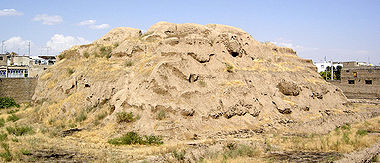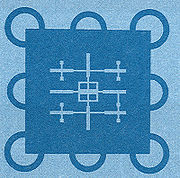
Meimoon Ghal'eh
Encyclopedia



Iran
Iran , officially the Islamic Republic of Iran , is a country in Southern and Western Asia. The name "Iran" has been in use natively since the Sassanian era and came into use internationally in 1935, before which the country was known to the Western world as Persia...
.
It sits in the middle of the city of Qazvin, hence heavily eroded, and is almost 5000 square meters in footage. The remains indicate the castle to have had a large dome in its central section. All ceilings no longer exist. The fortification has a subterranean network of 3 east-west tunnels under the structure connected by a north-south tunnel. The two levels were connected via a helical staircase. The main gates must have been on the northern side, it is believed. Eight towers made of brick surrounded the castle. All evidence indicates this structure to have been a military fortress of some sorts.
The castle's date of construction remains unknown, but it is currently thought to have belonged to the Abbaside era, possible constructed by the orders of Musa Al-hadi
Al-Hadi
Abu Abdullah Musa ibn Mahdi al-Hadi was the fourth Abbasid caliph who succeeded his father Al-Mahdi and ruled from 169 AH until his death in 170 AH ....
, the Caliph, in 784 AD. Some experts however believe it to belong to the Buyid
Buwayhid
The Buyid dynasty, also known as the Buyid Empire or the Buyids , also known as Buwaihids, Buyahids, or Buyyids, were a Shī‘ah Persian dynasty that originated from Daylaman in Gilan...
dynasty based on the artifacts unearthed at the site.
Nasīr al-Dīn al-Tūsī
Nasir al-Din al-Tusi
Khawaja Muḥammad ibn Muḥammad ibn Ḥasan Ṭūsī , better known as Naṣīr al-Dīn al-Ṭūsī , was a Persian polymath and prolific writer: an astronomer, biologist, chemist, mathematician, philosopher, physician, physicist, scientist, theologian and Marja Taqleed...
also spent some time here while residing with the Ismailis in the 13th century.
See also

- List of Iranian castles
- Iranian architectureIranian architectureIranian architecture or Persian architecture is the architecture of Iran . It has a continuous history from at least 5000 BCE to the present, with characteristic examples distributed over a vast area from Turkey to North India and the borders of China and from the Caucasus to Zanzibar...
- History of IranHistory of IranThe history of Iran has been intertwined with the history of a larger historical region, comprising the area from the Danube River in the west to the Indus River and Jaxartes in the east and from the Caucasus, Caspian Sea, and Aral Sea in the north to the Persian Gulf and the Gulf of Oman and Egypt...

